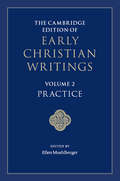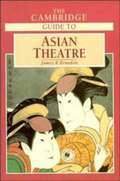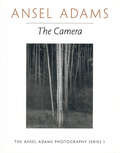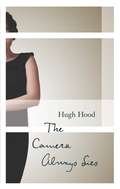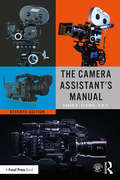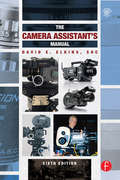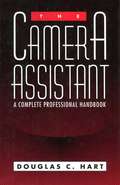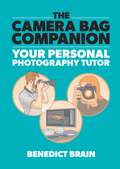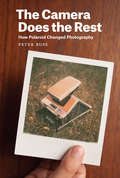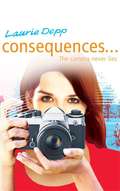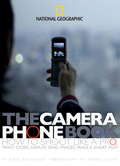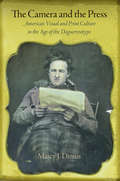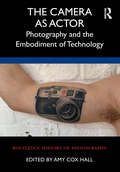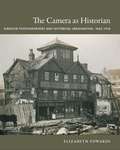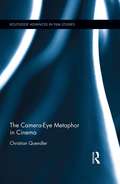- Table View
- List View
The Cambridge Edition of Early Christian Writings: The Cambridge Edition of Early Christian Writings
by Ellen MuehlbergerThe Cambridge Edition of Early Christian Writings provides definitive anthology of early Christian texts, from c. 100 to 650 CE. Its six volumes reflect the cultural, intellectual and linguistic diversity of early Christianity and are organized thematically on the topics of God, practice, Christ, community, reading and creation. The series expands the pool of source material to include not only Greek and Latin writings, but also Syriac and Coptic texts. Additionally, the series rejects a theologically normative view by juxtaposing texts that were important in antiquity but later deemed 'heretical', with orthodox texts. The translations are accompanied by introductions, notes, suggestions for further reading and scriptural indices. The second volume is focused on the topic of practice, including texts on education, advice, forming communities and instructing congregations. It will be an invaluable resource for students, academic researchers in early Christian studies, history of Christianity, theology, religious studies and late antique Roman history.
The Cambridge Encyclopedia of Stage Actors and Acting
by Simon WilliamsActing is widely acknowledged to be the central art of the theatre and has a long and vibrant history. With over 1,000 entries, this is the first encyclopedia of stage actors and acting around the world. More than 100 renowned international contributors provide biographical, historical and technical information about actors both familiar and obscure whose work has been crucial in the development of acting methods and traditions from classical theatre to the present day. Entries on key directors, theorists and teachers and on the elements and genres of acting provide insights into the history of acting as an art and its current practice. Including a chronological list of actors that spans the past 2,000 years and many diverse countries and cultures, this Encyclopedia offers a fascinating and unique overview of acting onstage that will be of interest to anyone who attends or practises theatre.
The Cambridge Guide to Asian Theatre
by James R. BrandonThis paperback edition, incorporating corrections and updates, contains more distilled information on the theatrical arts of Asia-Oceania than any other single volume yet published. A broad-ranging pan-Asian essay lucidly explores the basic themes of ritual, dance, puppetry, masks, training, performance, while national entries provide the historical development of theater in twenty countries. Major theater forms of each country are accompanied by entries on significant playwrights, actors and directors. An index and reading lists make this work indispensable.
The Cambridge Handbook of Creativity
by Robert J. Sternberg James C. Kaufman"The Cambridge Handbook of Creativity is a comprehensive scholarly handbook on creativity from the most respected psychologists, researchers, and educators. This handbook serves both as a thorough introduction to the field of creativity and as an invaluable reference and current source of important information. It covers such diverse topics as the brain, education, business, and world cultures. The first section, "Basic Concepts," is designed to introduce readers to both the history of and key concepts in the field of creativity. The next section, "Diverse Perspectives of Creativity," contains chapters on the many ways of approaching creativity. Several of these approaches, such as the functional, evolutionary, and neuroscientific approaches, have been invented or greatly reconceptualized in the last decade. The third section, "Contemporary Debates," highlights ongoing topics that still inspire discussion. Finally, the editors summarize and discuss important concepts from the book and look to what lies ahead"--Provided by publisher.
The Cambridge Introduction to Comedy
by Eric Weitz'Laughter', says Eric Weitz, 'may be considered one of the most extravagant physical effects one person can have on another without touching them'. But how do we identify something which is meant to be comic, what defines something as 'comedy', and what does this mean for the way we enter the world of a comic text? Addressing these issues, and many more, this is a 'how to' guide to reading comedy from the pages of a dramatic text, with relevance to anything from novels and newspaper columns to billboards and emails. The book enables you to enhance your grasp of the comic through familiarity with characteristic structures and patterns, referring to comedy in literature, film and television throughout. Perfect for drama and literature students, this Introduction explores a genre which affects the everyday lives of us all, and will therefore also capture the interest of anyone who loves to laugh.
The Cambridge Introduction to Performance Theory
by Simon ShepherdWhat does 'performance theory' really mean and why has it become so important across such a large number of disciplines, from art history to religious studies and architecture to geography? In this introduction Simon Shepherd explains the origins of performance theory, defines the terms and practices within the field and provides new insights into performance's wide range of definitions and uses. Offering an overview of the key figures, their theories and their impact, Shepherd provides a fresh approach to figures including Erving Goffman and Richard Schechner and ideas such as radical art practice, performance studies, radical scenarism and performativity. Essential reading for students, scholars and enthusiasts, this engaging account travels from universities into the streets and back again to examine performance in the context of political activists and teachers, countercultural experiments and feminist challenges, and ceremonies and demonstrations.
The Cambridge Introduction to Scenography
by Philip Butterworth Joslin MckinneyScenography - the manipulation and orchestration of the performance environment - is an increasingly popular and key area in performance studies. This book introduces the reader to the purpose, identity and scope of scenography and its theories and concepts. Settings and structures, light, projected images, sound, costumes and props are considered in relation to performing bodies, text, space and the role of the audience. Concentrating on scenographic developments in the twentieth century, the Introduction examines how these continue to evolve in the twenty-first century. Scenographic principles are clearly explained through practical examples and their theoretical context. Although acknowledging the many different ways in which design shapes the creation of scenography, the book is not exclusively concerned with the role of the theatre designer. In order to map out the wider territory and potential of scenography, the theories of pioneering scenographers are discussed alongside the work of directors, writers and visual artists.
The Cambridge Introduction to Theatre Directing
by Christopher Innes Maria ShevtsovaThis Introduction is an exciting journey through the different styles of theatre that twentieth-century and contemporary directors have created. It discusses artistic and political values, rehearsal methods and the diverging relationships with actors, designers, other collaborators and audiences, and treatment of dramatic material. Offering a compelling analysis of theatrical practice, Christopher Innes and Maria Shevtsova explore the different rehearsal and staging principles and methods of such earlier groundbreaking figures as Stanislavsky, Meyerhold and Brecht, revising standard perspectives on their work. The authors analyse, as well, a diverse range of innovative contemporary directors, including Ariane Mnouchkine, Elizabeth LeCompte, Peter Sellars, Robert Wilson, Thomas Ostermeier and Oskaras Koršunovas, among many others. While tracing the different roots of directorial practices across time and space, and discussing their artistic, cultural and political significance, the authors provide key examples of the major directorial approaches and reveal comprehensive patterns in the craft of directing and the influence and collaborative relationships of directors.
The Cambridge Introduction to Theatre Studies
by Christopher B. BalmeProviding thorough coverage of the methods and tools required in studying historical and contemporary theatre, this Introduction examines the complexities of a rapidly changing and dynamic discipline. Following a cross-cultural perspective, the book surveys the ways theatre and performance are studied by looking initially at key elements such as performers, spectators and space. The central focus is on methodology, which is divided into sections covering theatre theory, historiography and textual and performance analysis. The book covers all the main theatrical genres - drama, opera and dance - providing students with a comparative, integrated perspective. Designed to guide students through the academic dimension of the discipline, the volume emphasizes questions of methodology, research techniques and approaches, and will therefore be relevant for a wide variety of theatre studies courses. Informative textboxes provide background on key topics, and suggestions for further reading are included at the end of each chapter.
The Camera (Ansel Adams Photography Ser. #Vol. 1)
by Ansel Adams Robert BakerThis is an atrractively priced photography classic made accessible to a wider, new audience. It covers everything from "seeing" the finished photo in advance, to lens choices. It is illustrated with many of Ansel Adams most famous images.
The Camera Always Lies
by Hugh HoodFilmmaker Rose Leclair is beautiful, famous, and happily married. But when a new star actress begins commanding unwelcome amounts of attention--even, reportedly, from Rose's own husband--her life of privilege unspools. First published in 1967, The Camera Always Lies is an absorbing novel of Hollywood politics and one woman's struggle to survive them.
The Camera Assistant's Manual
by David E. Elkins SocExcel as a Cameraman in today’s evolving film industry with this updated classic. Learn what to do – and what NOT to do – during production and get the job done right the first time. This seventh edition covers the basics of cinematography and provides you with the multi-skill set needed to maintain and transport a camera, troubleshoot common problems on location, prepare for job interviews, and work with both film and digital technologies. Illustrations, checklists, and tables accompany each chapter and highlight the daily workflow of an Assistant Cameraman (AC), with expanded sections on problems and troubleshooting, updated formulas, tables, and checklists, as well as new information on the differences between working in the United States and UK and additional information on working with digital technology. This is a must-have for anyone looking to succeed in this highly technical and ever-changing profession. This book features a comprehensive companion web site that offers plenty of useful resources, including online tutorials that ACs can easily access while on location and supplementary downloadable forms and checklists.
The Camera Assistant's Manual
by David E. Elkins, SOCExcel as an Assistant Cameraman (AC) in today’s evolving film industry with this updated classic. Learn what to do—and what NOT to do—during production and get the job done right the first time. The Camera Assistant’s Manual, Sixth Edition covers the basics of cinematography and provides you with the multi-skill set needed to maintain and transport a camera, troubleshoot common problems on location, prepare for job interviews, and work with the latest film and video technologies. Illustrations, checklists, and tables accompany each chapter and highlight the daily workflow of an AC. This new edition has been updated to include: A fresh chapter on the entry level camera positions of Camera Trainee/Production Assistant Coverage of emerging iPhone apps that are used by filmmakers and ACs on set An updated companion website offering online tutorials, clips, and techniques that ACs can easily access while on location (www.cameraassistantmanual.com) All new sample reports and forms including AC time cards, resumé templates, a digital camera report, and a non-prep disclaimer Instruction and custom forms to help freelance filmmakers keep track of daily expenses for tax purposes The Camera Assistant’s Manual, Sixth Edition is an AC's bible for success and a must-have for anyone looking to prosper in this highly technical and ever-changing profession.
The Camera Assistant: A Complete Professional Handbook
by Douglas HartVeteran camera assistant Doug Hart describes in this comprehensive technical guide all of the important facets and duties of the first and second camera assistants' jobs. Whether it is feature films, episodic television, documentaries, commercials, or music videos, The Camera Assistant: A Complete Professional Handbook explains both the practice and theory behind it with a concentration on technique rather than equipment. In addition, personal anecdotes from the author's years behind and beside the camera provide insight into this demanding field. Key topics include film formats and aspect ratios, testing lenses and camera equipment, focus theory, film loading and labeling, scene blocking, marking actors, shooting tips, slating, paperwork, equipment maintenance, set etiquette, and finding work. This is not a camera equipment handbook; it is a comprehensive procedures manual which describes and explains the most important responsibilities of the camera assistant on the set, the theory behind the practice, and the methods that get the job done properly and keep the assistant frequently employed. Douglas C. Hart has been a freelance first-camera assistant on feature films, documentaries, television shows, and commercials for more than 20 years, including 10 years (and 10 films) as first-camera assistant to Gordon Willis, ASC, as well as work in 42 states and 26 foreign countries. His work includes Presumed Innocent, Hannah and Her Sisters, The Cosby Mysteries, and CBS's Central Park West. He is a member and former president of the International Photographers Local 644, IATSE, and teaches the Camera Assistant Workshops at the International Film and Television Workshops in Rockport, Maine.
The Camera Bag Companion: A Graphic Guide to Photography
by Benedict BrainAre you ready for a completely new type of photography book?Imagine having your personal, professional photographer with you whenever you go out to shoot. There to guide you, share their knowledge, and inspire you to take better photographs.In his latest book, Benedict Brain puts himself in your kitbag, with a beautifully illustrated how-to guide that's as essential as any lens or tripod, and cuts through the jargon to deliver clear advice in a friendly, conversational style.
The Camera Bag Companion: A Graphic Guide to Photography
by Benedict BrainAre you ready for a completely new type of photography book?Imagine having your personal, professional photographer with you whenever you go out to shoot. There to guide you, share their knowledge, and inspire you to take better photographs.In his latest book, Benedict Brain puts himself in your kitbag, with a beautifully illustrated how-to guide that's as essential as any lens or tripod, and cuts through the jargon to deliver clear advice in a friendly, conversational style.
The Camera Does the Rest: How Polaroid Changed Photography
by Peter BuseIn a world where nearly everyone has a cellphone camera capable of zapping countless instant photos, it can be a challenge to remember just how special and transformative Polaroid photography was in its day. And yet, there’s still something magical for those of us who recall waiting for a Polaroid picture to develop. Writing in the context of two Polaroid Corporation bankruptcies, not to mention the obsolescence of its film, Peter Buse argues that Polaroid was, and is, distinguished by its process—by the fact that, as the New York Times put it in 1947, “the camera does the rest.” Polaroid was often dismissed as a toy, but Buse takes it seriously, showing how it encouraged photographic play as well as new forms of artistic practice. Drawing on unprecedented access to the archives of the Polaroid Corporation, Buse reveals Polaroid as photography at its most intimate, where the photographer, photograph, and subject sit in close proximity in both time and space—making Polaroid not only the perfect party camera but also the tool for frankly salacious pictures taking. Along the way, Buse tells the story of the Polaroid Corporation and its ultimately doomed hard-copy wager against the rising tide of digital imaging technology. He explores the continuities and the differences between Polaroid and digital, reflecting on what Polaroid can tell us about how we snap photos today. Richly illustrated, The Camera Does the Rest will delight historians, art critics, analog fanatics, photographers, and all those who miss the thrill of waiting to see what develops.
The Camera Never Lies (Consequences #2)
by Jez HoldsworthNathalie has dreamed of being a serious photographer ever since she got her first camera at 8 years old. She aspires to be like her heroine, Annie Leibowitz and take fabulous soulful pictures.
The Camera Phone Book
by Aimee BaldridgeMarketing experts predict that by 2009, nearly 90% of all cell phones will contain a camera, as manufacturers race to create cheaper, easier-to-use models with more sophisticated cameras, more pixels, flash units and even multiple lenses. Already revolutionizing audiovisual communication, it's a trend that will only grow more explosively—and who better than National Geographic to create a how-to book aimed directly at the millions who carry a camera phone everywhere and want to make the most of it? Created by two top professionals, this generously illustrated nuts-and-bolts guide is the first of its kind to treat these units as genuine cameras instead of novelties, and the only one to include a full-color photo-essay demonstrating the full capabilities of the latest camera phones. In five easy-to-read chapters, the book explains how to choose good equipment; take better pictures; and store, print and send the best images. Readers will find practical tips on preventing or repairing water damage, protecting easily-scratched lenses inside pockets and purses, and retrieving accidentally-erased images. They'll also learn to access the events, advice, and opportunities of the burgeoning camera phone community, from film festivals to news organizations, moblogs, and more. Featuring the technical savvy of CNet.com's Aimee Baldridge and the creative skill of National Geographic photographer Robert Clark, a camera phone pioneer, this compact yet comprehensive reference combines up-to-the-minute expertise with superb examples, at an inexpensive price that makes it a perfect gift book—or an ideal impulse buy.
The Camera Phone Book
by Robert Clark Aimee BaldridgeMarketing experts predict that by 2009, nearly 90% of all cell phones will contain a camera, as manufacturers race to create cheaper, easier-to-use models with more sophisticated cameras, more pixels, flash units and even multiple lenses. Already revolutionizing audiovisual communication, it's a trend that will only grow more explosively--and who better than National Geographic to create a how-to book aimed directly at the millions who carry a camera phone everywhere and want to make the most of it?Created by two top professionals, this generously illustrated nuts-and-bolts guide is the first of its kind to treat these units as genuine cameras instead of novelties, and the only one to include a full-color photo-essay demonstrating the full capabilities of the latest camera phones. In five easy-to-read chapters, the book explains how to choose good equipment; take better pictures; and store, print and send the best images. Readers will find practical tips on preventing or repairing water damage, protecting easily-scratched lenses inside pockets and purses, and retrieving accidentally-erased images. They'll also learn to access the events, advice, and opportunities of the burgeoning camera phone community, from film festivals to news organizations, moblogs, and more.Featuring the technical savvy of CNet.com's Aimee Baldridge and the creative skill of National Geographic photographer Robert Clark, a camera phone pioneer, this compact yet comprehensive reference combines up-to-the-minute expertise with superb examples, at an inexpensive price that makes it a perfect gift book--or an ideal impulse buy.
The Camera Phone Book: How to Shoot Like a Pro, Print, Store, Display, Send Images, Make a Short Film
by Aimee BaldridgeReaders will find practical tips on preventing or repairing water damage, protecting easily-scratched lenses inside pockets and purses, and retrieving accidentally-erased images. They'll also learn to access the events, advice, and opportunities of the burgeoning camera phone community, from film festivals to news organizations, moblogs, and more.
The Camera and the Press
by Marcy J. DiniusBefore most Americans ever saw an actual daguerreotype, they encountered this visual form through written descriptions, published and rapidly reprinted in newspapers throughout the land. In The Camera and the Press, Marcy J. Dinius examines how the first written and published responses to the daguerreotype set the terms for how we now understand the representational accuracy and objectivity associated with the photograph, as well as the democratization of portraiture that photography enabled.Dinius's archival research ranges from essays in popular nineteenth-century periodicals to daguerreotypes of Americans, Liberians, slaves, and even fictional characters. Examples of these portraits are among the dozens of illustrations featured in the book. The Camera and the Press presents new dimensions of Nathaniel Hawthorne's The House of the Seven Gables, Herman Melville's Pierre, Harriet Beecher Stowe's Uncle Tom's Cabin, and Frederick Douglass's The Heroic Slave. Dinius shows how these authors strategically incorporated aspects of daguerreian representation to advance their aesthetic, political, and social agendas. By recognizing print and visual culture as one, Dinius redefines such terms as art, objectivity, sympathy, representation, race, and nationalism and their interrelations in nineteenth-century America.
The Camera as Actor: Photography and the Embodiment of Technology (Routledge History of Photography)
by Amy Cox HallLooking beyond the impact photographs have on the perpetuation and expression of social norms and stereotypes, and the influence of the act of taking a photograph, this new collection brings together international scholars toexamine the camera itself as an actor. Bringing the camera back into view, this volume furthers our understanding of how, and in what ways, imaging technology shapes us, our lives, and the representations out of which we fashionknowledge, base our judgments and ultimately act. Through a broad range of case studies, the authors in this collection make the convincing claim that the camera is much more than a mechanical device brought to life by the photographer. This book will be of interest to scholars in photography, visual culture, anthropology and the history of photography.
The Camera as Historian: Amateur Photographers and Historical Imagination, 1885–1918 (OBJECTS / HISTORIES Critical Perspectives on Art, Material Culture, and Representation)
by Elizabeth Edwards Nicholas ThomasIn the late nineteenth century and early twentieth, hundreds of amateur photographers took part in the photographic survey movement in England. They sought to record the material remains of the English past so that it might be preserved for future generations. In The Camera as Historian, the groundbreaking historical and visual anthropologist Elizabeth Edwards works with an archive of nearly 55,000 photographs taken by 1,000 photographers, mostly unknown until now. She approaches the survey movement and its social and material practices ethnographically. Considering how the amateur photographers understood the value of their project, Edwards links the surveys to concepts of leisure, understandings of the local and the national, and the rise of popular photography. Her examination of how the photographers negotiated between scientific objectivity and aesthetic responses to the past leads her to argue that the survey movement was as concerned with the conditions of its own modernity and the creation of an archive for an anticipated future as it was nostalgic about the imagined past. Including more than 120 vibrant images, The Camera as Historian offers new perspectives on the forces that shaped Victorian and Edwardian Britain, as well as on contemporary debates about cultural identity, nationality, empire, material practices, and art.
The Camera-Eye Metaphor in Cinema (Routledge Advances in Film Studies)
by Christian QuendlerThis book explores the cultural, intellectual, and artistic fascination with camera-eye metaphors in film culture of the twentieth century. By studying the very metaphor that cinema lives by, it provides a rich and insightful map of our understanding of cinema and film styles and shows how cinema shapes our understanding of the arts and media. As current new media technologies are attempting to shift the identity of cinema and moving imagery, it is hard to overstate the importance of this metaphor for our understanding of the modalities of vision. In what guises does the "camera eye" continue to survive in media that is called new?
